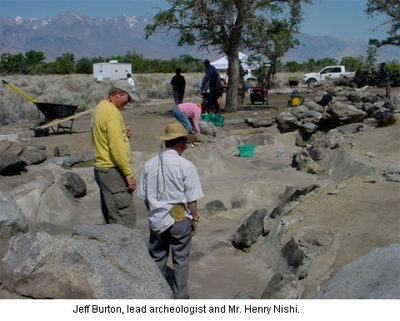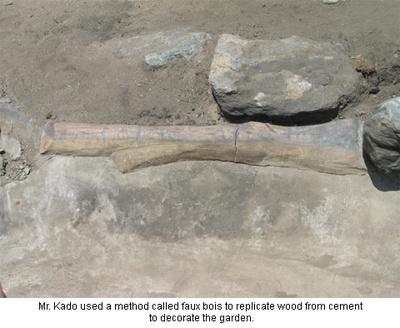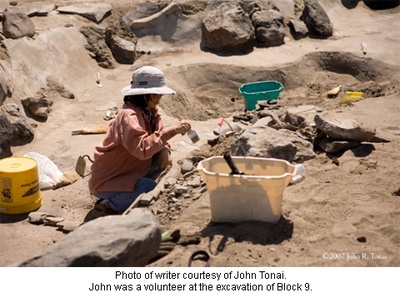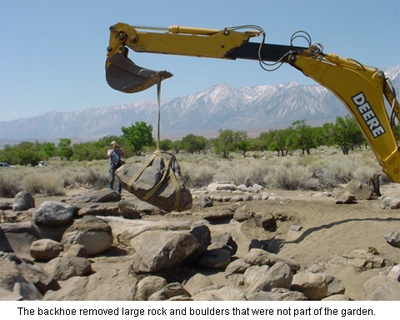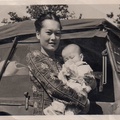On my birthday, May 6, 2007, I got an e-mail from my friend Park Ranger Carrie Andresen-Strawn at the Manzanar National Historic Site Interpretive Center. She wanted to know if I would like to volunteer on an excavation of two gardens at Blocks 9 and 10. These two blocks housed most of the Terminal Islanders who were forced to leave their homes, businesses and give up their livelihood and their successful occupations as fishermen.
A majority of the population were sent to Manzanar, their only crime was looking like the enemy and living near a military facility. Many of the older first generation (Issei) had been already targeted by the FBI and were quickly picked up on the evening of December 7, 1941 or shortly after. They were taken away with their families left to fend for themselves. The Issei were then secretly taken to Tuna Canyon, also called Tujunga, a deserted Conservation Corp Camp in Glendale. This was to be one of the first detention centers created for incarcerating an innocent group of people without due process.
The Block 9 garden was designed by Ryozo Kado. He constructed the cemetery tower, guard houses and other gardens in Manzanar with the help of the Terminal Islanders. If you would like more information on Mr. Kado please read Ron Beckwith’s article, "Landscape Gardens and Gardeners at Manzanar Relocation Center."
I thought I would like to participate because I have a great interest in Terminal Island, Manzanar, early settlers and Native American history and there was all of that to be found at Manzanar.
As I was driving to Manzanar, I thought to myself, “Will this be exciting? Interesting? Or was there a chance it would be boring?” When I met the National Park lead archeologist Jeff Burton, I realized he was the author of Confinement and Ethnicity, a book that I use and recommend frequently to those researching the history of the “camps” where I work which is the Hirasaki National Resource Center in the Japanese American National Museum. I started to name the other titles of his books that I knew he had written on Manzanar.
My second surprise was when I met Ron Beckwith. He has also contributed to Confinement and Ethnicity and other publications as an archeologist and cartographer. There was also a volunteer named Dick Lord who was the photographer. I also worked with three great volunteers, Carrie Hearn, Loretta Howard, and Sande Bilyeu.
Jeff marked off the site but you would have never known there was a garden. It was completely covered with soil, vegetation, and large rocks that barely peeked through the surface. Jeff had started excavating the top of the garden which was the high point that allowed the water to flow down. The first task was to clear the brush and then gather any artifacts on the surface. I found some marbles, nails, and pieces of window glass. The objects were put into buckets later to be marked with location and then later sent off to the Western Archeological Conservation Center in Tucson, Arizona.
I would like to mention Jeff Burton and Ron Beckwith have worked on the archeology of Manzanar starting with prehistory of the Native Americans that lived in the area, the Paiutes and Shoshones. The town was named Manzanar from Spanish meaning “apple orchard” and the early settlers grew apples which were one of the best tasting. It was a thriving town until Los Angeles needed water. The city eventually bought the land and the town disappeared until 1942 when Manzanar rose up again—not as a town, but a concentration camp for those of Japanese descent, a majority being U.S. citizens including my father’s family, the Saitos.
My aunt and uncle, Otome and John were among about 100 to leave early from Little Tokyo in Los Angeles and help set up Manzanar before the rest of the population would arrive. My other aunt, Takako, became one of the librarians at Manzanar and utilized her skills by making a working library and improvising materials to make much needed book shelves. Her education was cut short because of her incarceration; she was going to USC studying Library Science and English. Grandmother Nobue and another uncle Henry were also incarcerated.
When we cleared the brush and started to remove more of the dirt, little by little the area started to unveil the definition of a garden. The archeologists found part of a border made of cement that surprisingly looked like a log and branches. This method is called Faux Bois. It had a slight reddish brown tint that had faded through time. The more dirt I removed the more logs started to appear. As I cleared and brushed to expose the cement logs I started to imagine why they had designed and then built these gardens. My conclusion was they wanted to create a beautiful place for a brief time and forget their uncomfortable living conditions and their sad existence.
There were personal gardens, victory gardens, and the mess hall gardens usually built between a barrack and the mess hall. It brought some respite to the people waiting in long lines. There was also a hospital garden for those recuperating to find some comfort.
As more dirt was removed, more of the logs, decorative rocks and artifacts were revealed. Manzanar had water and expert landscapers so that is why there were so many beautiful gardens.
More removal of soil revealed some artifacts and this was very exciting. I found a glass inkwell and a few more were found; I wondered if the people at Manzanar wrote as they sat by the garden composing poems, stories or maybe letters. I also found an unbroken milk bottle with the words “Bonham Brothers Dairy” and “Lone Pine, Calif.” printed on it. After the camp closed, government workers bulldozed and dumped trash into the garden and then proceeded to burn it.
The more dirt I would remove, I couldn’t wait to see what new artifact I would find. There was plasterboard, linoleum, roofing material, a Coca Cola bottle, a large mug, and tin cans. To our surprise it extended longer than Jeff thought, so this was one of the longest garden/ponds he has uncovered. To see the garden fully exposed was exhilarating.
When we finished the excavation Jeff put water at the top where the source would have been. As we watched it run down over and under rocks at different levels making sounds almost like music as Mr. Kado had said in one of his interviews for a Saturday Evening Post magazine. The magazine featured his masterful work of the grottos and gardens that he had built for the Archdiocese after he and his family left Manzanar.
I always enjoyed history and archeology and the Manzanar National Historic Site allowed me to be part of it. My father’s family lived in Block 33 near Merritt Park, a large and beautiful garden/pond with a pavilion and bridge and there was another beautiful garden/pond in Block 34. These gardens are there for the public to enjoy and view, so when you visit the Manzanar National Historic Site, please hike or go on the auto tour, but park your car and walk a short distance to some of the gardens. Block 34 garden is accessible to all. There is a sidewalk leading to the garden. Everyone can enjoy the beauty built by those who didn’t allow such a terrible experience to completely keep them down; they persevered.
Manzanar is protected and stands to educate and keep the legacy going so history will not repeat itself and fail any United States American, again thanks to volunteers who dedicated themselves to telling the Manzanar story like Sue Embrey and others. Manzanar’s gardens are there to be enjoyed and the beauty will endure as the spirit of those that were once in Manzanar. If you are driving along Highway 395, take the time to stop and enjoy the wonderful interpretive sites at Manzanar.
It’s my birthday again….. and soon I will be off to volunteer again at Manzanar National Historic Site. This time it’s going to be Merritt Park or Pleasure Park between blocks 33 and 34……...
© 2008 Marie Masumoto



